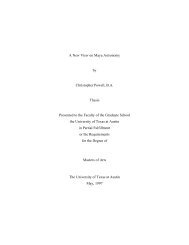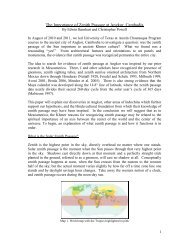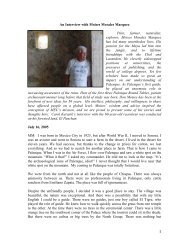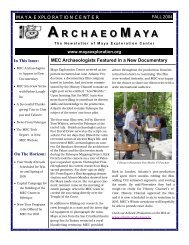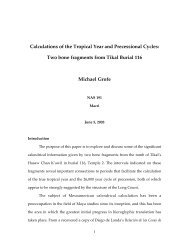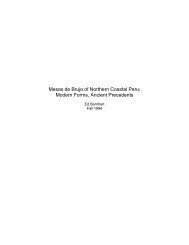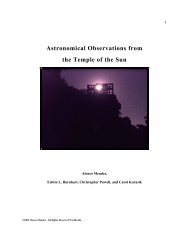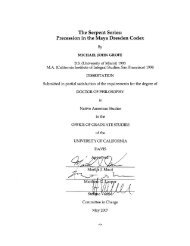Shamanism in Moche Art and Iconography - Maya Exploration Center
Shamanism in Moche Art and Iconography - Maya Exploration Center
Shamanism in Moche Art and Iconography - Maya Exploration Center
You also want an ePaper? Increase the reach of your titles
YUMPU automatically turns print PDFs into web optimized ePapers that Google loves.
&RH 395Spr<strong>in</strong>g 1994
Tntr~ductiori..................................,........~~TabLe-~-f-C~nt~!_t.z.7Modern Peruvian <strong>Shamanism</strong> ............................... 4F'The Shaman <strong>and</strong> His Deity <strong>in</strong> <strong>Moche</strong> Ark ...................JThe Hur~ners.................................,............BTiahuenaco-H1.1ari..................................~.....9Psracas Necropolis/Na~ca........~. u~...........o.sv.....il~JCha~<strong>in</strong>..................................~.......~......l.3'The fires~?ntation Ceremony. .............................Float<strong>in</strong>g Spirits .................................u...n.,, 17.I&I'he Decapitator. ....................................... 19I: 7 -2The Puppy........ ..........................................Se>:~tal Pnttery..... .................................... 2317 r-The Mesa de Hrujo.. ...................... .............Manioc....... ...................................... #-..26~The Sione Novice E:cperience.. ..........................28L.~?Conclusion...................................u..s..v..,,2YBibliography ............................ "........m......31.List of Figcu-cs.. ....................................... .,7r ..
that Elizabeth Nenson called the Fanged Ueity(Penson 1972;27).The snaC::es cam<strong>in</strong>g off the Del t of th@ h@sler <strong>in</strong> Figl..rre 5 are alsoreserved sol el y for the depictions of shamans..The four <strong>in</strong>dividl.lalcs <strong>in</strong> F'ig~lre 6 wear both l.::'<strong>in</strong>ds ofheaddresses shown <strong>in</strong> the previous figures.Three of the men nitwi.th lime gourds while the fourth st<strong>and</strong>s head <strong>and</strong> h<strong>and</strong>s held Liptowards a dout:)led headed arch which represents the sk:y.Float<strong>in</strong>g.ara~lnd ~1.1.1. fo~lr men are lar'gv9 dots which may be e:.:pla<strong>in</strong>ecl asentoptic forms seen <strong>in</strong> the first stages of hall~~ciriations(Ostcr:l.Y?0;87).Support<strong>in</strong>g e!vj.dence for that e::pl.anat,ion can be foundj.n the lower- 1,rf.t carner of Fig~.tre 4. 'The two plants thrz.rc maybe identified as; San Pedro cactu!ii; <strong>and</strong> the Misha Negra plnn.t, both';are lhal luc<strong>in</strong>ogr?nic plwnts employed by the moder-n Mochc? shaman <strong>in</strong>hr.a:l..i rlrJ r'i. tual so. The ?jt~\r~cli rlg man's moi.lth is oper~ I. t is proposec:l'that he i s s<strong>in</strong>g<strong>in</strong>g. S<strong>in</strong>g<strong>in</strong>g is a st<strong>and</strong>arF.d methnd of cal.l<strong>in</strong>$; oi.lCrthe spirit.: enlp:l. oyecl by modern shamans irl west.ern Sontt~ lAmerica.Tri OLI% i ~na <strong>and</strong> IMatisigenl.:a heal<strong>in</strong>g ri t~.ra:ls, the shaman reqr.rires achart-1% n,i women whn call the spirjts out of the forfist w5.t.h theirs<strong>in</strong>g:<strong>in</strong>g (1'01 lock 1992~33 arid Haer 1992; 90). Ilodern Nazca <strong>and</strong>Plorhr? ter-ritory shamans do the s<strong>in</strong>g<strong>in</strong>9 them~elveg wh1.1~. . -a-ktendarits perSorm the actions(Had<strong>in</strong>gl1arn 1987i247 <strong>and</strong> G i l l <strong>in</strong>1947; 121). Tn S:i.ona society each spirit has a speci.iic song, themore song:;one k:nows, the mnre pawer he has!Matte!son L.angrlon1'7c9;lg 5::;) "There are many ntheie- depictions of men weari.nc] a jag1.1ar
headdress such as the one displayed <strong>in</strong> Figure Si;(Figures 7-9).There is, however, another contest <strong>in</strong> which the same headdress isworn by a deity(Figurrs 1Ct-13).This deity has charactel-isticswhich separate him from the depictions of shamans.Round eyes,elongated fangs, wrank:le l<strong>in</strong>es an his face, snake earr<strong>in</strong>gs <strong>and</strong>the jaguar headdress are his pr<strong>in</strong>cipal elements. The "FangedUeity" is Elizabeth Benson '5 term for this Deity (Denson 1972;27) ..In the same way as the deity is the master 0.f the spiritrs, theShaman emulates him <strong>in</strong> costume to identify himself as a humanmaster of spirits.The Desana say that a deity named Viho Hahse was placed <strong>in</strong>tne Milky Way by the Sun a5 an <strong>in</strong>termediary between the worlds.'iHis name comes from the word Viha which means halluc<strong>in</strong>ogenicsnuf.f.He is lord of the spirit world whom the Deeana payesvisit dur<strong>in</strong>g trance(Heiche1-Dolmatoff 1968; 411). It is also saidthat th19 Sun created the jaguar as his representative onEarth (ReicheX-Dolmatoff 1968; 28).~ukdreds bf milea to the south<strong>in</strong> Bolivia, Aymara is the name of a great fel<strong>in</strong>e deity that isboth a protector <strong>and</strong> a destroymr(Had<strong>in</strong>gham 1987;247).Modernlil~lechua sick are said to suffer from attacks by Ccok, fly<strong>in</strong>g.-fel<strong>in</strong>e m<strong>in</strong>ions of the Mounta<strong>in</strong>/wcather Deity (liad<strong>in</strong>gham 1987; 248).All of these beliefs may well be relatmd to concepts aboutshamanism <strong>and</strong> the other-world that developed long before Incasociety began.Music is another component of ritual well known to be
connected to shamanism <strong>and</strong> the call<strong>in</strong>g out of spirits.Many ofthe <strong>in</strong>dividuals play<strong>in</strong>g flutes or horns displayed <strong>in</strong> <strong>Moche</strong> artcan be seen wear<strong>in</strong>g the jaguar headdress(Figure5 14-16).Musicians are most often shown <strong>in</strong> ceremonial or processionalscenes.Fj.gure '17 shkws a Yanamamo shaman play<strong>in</strong>g a set o.F pipes, .over three piles of Banisterapsis v<strong>in</strong>es, a halluc<strong>in</strong>ogen boiled<strong>in</strong>to a dr<strong>in</strong>k used dur<strong>in</strong>g heal<strong>in</strong>g rituals all over the fimazon.Tb!-!.u_r,!e_rrThe Runners are a frequent theme <strong>in</strong> <strong>Moche</strong> vessel pa<strong>in</strong>t<strong>in</strong>ge.The 5t<strong>and</strong>ard runner scene shows a s<strong>in</strong>ge file row of men runn<strong>in</strong>gI.across a l<strong>and</strong>scape of cactus <strong>and</strong> pllnts(Figures 18-20).tanalternate sccne is one <strong>in</strong> which the men are replaced byanthropomarphs(Fig~~res 21-24). In both versions nf the scenemost of the runners wear the jaguar headdress of the shaman.Some marly rcholars connected them td ths <strong>in</strong>iza <strong>and</strong> chimumessengers who ran along the roads(Way1e 1965;67).Othersbe1 ievad them to be warriors (Ubbclohde-.,Doer<strong>in</strong>g 1992; 183).Elizabeth Benson suggested the bags the runners carry may holdLima bvans ~tsed for div<strong>in</strong>ation purposes (B@!nson 1972; $13).. .The bagof herbs found on the Nesa de Erujn of the modern <strong>Moche</strong> s.hamansis anothmr possible e<strong>and</strong>idwte(Gill <strong>in</strong> 1947;23).The l<strong>and</strong>scapeitself <strong>in</strong>dicates the runner are <strong>in</strong>deed shamans, as Wensonimplied.The plant epocics depicked may once aga<strong>in</strong> be identified
as the halluc<strong>in</strong>ogens, San Pedro cactus <strong>and</strong> the.Misha Negrr plant.Exam<strong>in</strong>ed through the 1 enss of shamanism, the anthropomorphs whoreplace the men <strong>in</strong> the runner scenes may be expla<strong>in</strong>ed as shamans<strong>in</strong> the process of transformation.The runners are consistently shawn runn<strong>in</strong>g over hi 11 yl<strong>and</strong>scape or uphll l (Figure 24).'The ethnographic record islack<strong>in</strong>g <strong>in</strong> accuunts describ<strong>in</strong>g ceremonies of this nature thaughthe follnw two examples may be related. First, <strong>in</strong> th~! NazcaVal l cy community of Puquiu, the Portgo {the most powerful shaman <strong>in</strong>the village) <strong>and</strong> fellow brujos used to climb a sacred mm.~nta<strong>in</strong>near Puq~tio each August to make offer<strong>in</strong>gs for water (Had<strong>in</strong>gham1987;247). Sec<strong>and</strong>,<strong>in</strong> 1985, Johan Re<strong>in</strong>hard witnessed a ceremony~.<strong>in</strong> a Bolivian village <strong>in</strong> which a l<strong>in</strong>e'(1ike the Nazca l<strong>in</strong>es) wasfollpwed s<strong>in</strong>gle file to higher ground where the people prayed forwater from the Mounta<strong>in</strong>s (Had<strong>in</strong>gham 1987;294).It is possiblethat the <strong>Moche</strong> shamans depicted on vessels as the runners mayalso be go<strong>in</strong>g to make of+er<strong>in</strong>gs for water.Tiah~~anaco-Huari euJ. ture dom<strong>in</strong>ated Peru from thc sixth to- ..tenth centuries. <strong>Moche</strong> art was heavily <strong>in</strong>fluenced by Tiahuanaco-kluari style <strong>in</strong> its f<strong>in</strong>al phases <strong>and</strong> bscomes the Lambayeq~.teculture.The Gateway of the Sun (Figure 27) , Tiahuanaco cul turer,most famous monument, appears to display shaman iconography suchas the types previously discusshd <strong>in</strong> <strong>Moche</strong> art,The central
<strong>in</strong>dividuals as the <strong>in</strong>divid~~als on the te:ctiles,Early scholarshave referred to them as deities, demons <strong>and</strong> spirits.EvanHadi,ngham has suggested that they are <strong>in</strong> fact shamans <strong>in</strong>trans+ormation (Had<strong>in</strong>gham 1987; 178). The paper agrees withHadi ngham's <strong>in</strong>t.erpret'ation <strong>and</strong> purposes further support<strong>in</strong>gevidence by l<strong>in</strong>k<strong>in</strong>g the costume of the Paracas shaman with thatof the previous1 y identified <strong>Moche</strong> shaman.Figure 35 showsfly<strong>in</strong>g Mache shamans with animal headdress, one jaguar, one bird,,snakes extend<strong>in</strong>g off the waist <strong>and</strong> out of the mouth, just re <strong>in</strong>the st<strong>and</strong>ard Faracas textile image.The headdress of the Faracaeshaman.;is an abstracto?d jaguar head with elungated whiskerswhich are sometimes snakes. Images pa<strong>in</strong>ted on pottery from the';Nazca, the <strong>in</strong>heritors of Paracas c~~lture, strongly sl.~pport thisobservatl on (Fig!.~res 37-3'7).An image from a Nazca mural showsshamans trarisform<strong>in</strong>g <strong>in</strong> the same costume as portrayed <strong>in</strong> theF'aracas textiles of centuries earlier (Figure 36).Though rare,images of both Paracas <strong>and</strong> Nasca shaman can 'be found <strong>in</strong> which theabstracted jaguar headdress is replaced with a more recognizabledepiction !Figure 40 <strong>and</strong> 41). The abstracted jaguar headdress wasan important enough imaye to be displayed <strong>in</strong> one of the famous. . .Nazca L<strong>in</strong>es(Figura 42).The Paracas/Nazca style of depict<strong>in</strong>g shamanrs differs fromthe Mocha depictions <strong>in</strong> one important way; the <strong>in</strong>cluaion ofsevered head%.They are displayed <strong>in</strong> the shamans h<strong>and</strong> or hang<strong>in</strong>goff his waist i,n many examples. Severed heads were apparently
part of the Paracas shaman's equipment or costume.A briefdiscussion of the Jivaro culture of the Eastern foothills of thsEcuadorian Andes may shed light on the practlee of headhunt<strong>in</strong>g.Up unti Xthis century, the Jivaro culture practiced bloodfe~tds which resulted <strong>in</strong> the decapitation <strong>and</strong> shr<strong>in</strong>k<strong>in</strong>g of theenemy heads. They are now broken of that habit by the Ecuadoriangovernment. The Jivaro revolted <strong>in</strong> 1599, twenty thous<strong>and</strong> strong,kill<strong>in</strong>g everyone <strong>in</strong> the closest Spanish village <strong>and</strong> pour<strong>in</strong>gmolten gold down the throat of the unfortunate Alcalde.6s aresult, they were left alonr unti 1 anthropologist Michael J.Harner 'tuuk an <strong>in</strong>terest <strong>in</strong> them <strong>in</strong> the 1950's(Had<strong>in</strong>gham 1987;163--164).':Harner spent fourte~n months among the Jivaro <strong>and</strong> acquiredsome. <strong>in</strong>trigu<strong>in</strong>g <strong>in</strong>formation about their culture. All men takecDaturata powerful halluc<strong>in</strong>ogen) at a young age, around six, <strong>and</strong>acquire an ancestor spirit called an Arutam. It comes t thenovice as a menac<strong>in</strong>g jag{-~ar, an anacdnda or 'a severed ~ L I an head.It lodges itself <strong>in</strong> the chest. The experience en~pwwers ndenrages the man. With<strong>in</strong> a few days of the ilcq~~isition of anArutam the novice must participate <strong>in</strong> a kill<strong>in</strong>g raid on enemies...Participation entitles him to ano'ther Arutam <strong>and</strong> "locks <strong>in</strong>" the,first soul.Kill<strong>in</strong>g is a dal.?yerous busi~iess because if not: donecorrectly the man's SOLII becomes a i.lui+ak or aveng<strong>in</strong>g soul.Itcomes out <strong>in</strong> the form of venomous snakes if not controlled.After death thfs head must he chopped off <strong>and</strong> shr~tnk <strong>in</strong> hot s<strong>and</strong>.
At 10,200.Ft, the site of Chav<strong>in</strong> de Huantar is named for theri~arby v:i.ll.age u+ Ckiaviri <strong>and</strong> was occupied from 1200-90t:)BC.In196'7 John Howe wrote a paper entitled "Form <strong>and</strong> Mean<strong>in</strong>g In Chav<strong>in</strong><strong>Art</strong>" <strong>in</strong> which he attempted to identify the iconographic programof the sculp't~~re at the temple ~itr~ictt.\rcs of Chav<strong>in</strong> de Huantar.'The ianzi.~~, is the- central image <strong>in</strong> the Old Temple at ~hav<strong>in</strong> deH~~anter, Rows calls it the Great 1mage(Fig~~tr&43).. Tht? image has.c?.longatecl fangs <strong>and</strong> snakes extend<strong>in</strong>g off its head <strong>and</strong> waist.Rnwe .then st.\ggests that the hlew Temple is dedicated to another:image with elongated fangs <strong>and</strong> sn;~kes e:.:tend<strong>in</strong>g off its head <strong>and</strong>wais+ he nwmes the Sliaf.6 God (f'j.g~.~re 44). HI? al.so identiSies athird deity <strong>in</strong> the Old T'??fliple's courtyard he names the Smil<strong>in</strong>gr., , -"?c.)d (I-igurc:? 413).I:Thc three images are separated from one anotheron th6.? basis of: post~lre <strong>and</strong> .faciill. o:pre:;riion.Rowe tool.:: thefanged mr~l.cth as a general. <strong>in</strong>dictor of deity status.I't is thr?position of this paper that post\.ire <strong>and</strong> facial. ~xpressior.1 are nntre1 iable <strong>in</strong>dicators of iclentity <strong>and</strong> that the 'three imager, are <strong>in</strong>+:act +:he same deity.Further, t,his "fanged deity" is the same ~4s;;the fanged deity <strong>Moche</strong> ghamans imitate <strong>in</strong> costume centurieslater. Other- scholars have notd the connection bekween the. ..f i3rlged r magss <strong>in</strong> Cl~av<strong>in</strong> <strong>and</strong> <strong>Moche</strong> art (Kublcr 1984; 394).'Thr? co~trtyard of the old temple at Chav<strong>in</strong> de H~tantwr isflankcd by bird anthrapomorphs. Howe calls these figuresg:..!ar.i::l:i.,7n.;::l:i n ancl .Chi $5 paper agr-~?es with hi!; assessmfi?r o w ? 19h7; .'The Plonhs Fanged Deity is fl-eq~~ently depicted with bird
assist his side <strong>in</strong> the battle.Figure 52 is another battle scene<strong>in</strong> which the only figure <strong>in</strong> the scene with a jag~lar headdressconjures a spirit to aid his side.The shaman blows <strong>in</strong>to a conchshell over a Nisha Negra plant as a spirit,'throw<strong>in</strong>g a spearmakerializes above him. In Figure 53 a spirit floats over thehead of the opponent of a man who wears the jaguar headdress.This shaman has his weapons held away from tho opponent <strong>and</strong> looks.up tnwards his protector spirit.These are but a few examples ofa common theme <strong>in</strong> <strong>Moche</strong> art <strong>in</strong> which <strong>Moche</strong> shaman are depicted anthe process of call<strong>in</strong>g out the spirits.TheDe_~.,s~~tatora.The Decapitator is the name gicen to an <strong>in</strong>dividr.lal who isfreq.uently depicted <strong>in</strong> <strong>Moche</strong> art.In his most st<strong>and</strong>ard pose hest<strong>and</strong>s arms outstretched, a severed head <strong>in</strong> one h<strong>and</strong> a tumi knife<strong>in</strong> the other (Figure 54).Elizabeth Benson notes diffic1.11ty <strong>in</strong>tell<strong>in</strong>g gods apart <strong>and</strong> considers the'Decapiifator simply theFanged Deity <strong>in</strong> another circumstance(Benson 1972;JO).Donnanseparates the Decapitator from Benson's Fanged Deity call<strong>in</strong>g it asupernatural be<strong>in</strong>g relatod to sacrifice(Alva <strong>and</strong> Donnan, ..1993; 139). The Decapitator is frequently shown captur<strong>in</strong>g an -opponsnt.In some scenes the opponent is a terrestrialcreature(Figures 55-57), <strong>in</strong> others the opponent is an oce<strong>and</strong>weller (Figures 58-62).A1 1 opponents of the Dscapitatnr are%c..~pernatural as evidenced by human limbs on sea creatures <strong>and</strong>
other <strong>in</strong>dicators.Henson notes that the Fanged Deity asderapit.atc~r taker; many form:;.'The crab is one of the mostfreqr..rent forms taken by theI.nterest:.i ng observat,ionthe Fanged Dt2j.t~ is thecaptures the crab (figurepostulated tl.lst the crab isof the FangedDeity wi.t:h whom he str~rggl edepictions of decapitators captl-r<strong>in</strong>g decapitators seem to SLIP~OItierhypatkiesis(fj.gures 57 <strong>and</strong> 59). The Nazca "St,orm God" is, ase:.:plairied by modern Nazca V
the <strong>Moche</strong> shaman (Figures 54-62). Modern <strong>in</strong>habj. tants 0.F the townnf <strong>Moche</strong> believe that when a c~rr<strong>in</strong>g shaman journeys to thcr!otherworld he w i l l be <strong>in</strong> conflict with the bad shaman or spiritresponsible for the illness.Cam<strong>in</strong>n ~alderon <strong>in</strong> 1752 <strong>and</strong> Gill<strong>in</strong><strong>in</strong> 1?47 both witness <strong>Moche</strong> +haman assistants pick up a ct?remonialbife 0f.f: the filesa de BruJo <strong>and</strong> flash it at <strong>in</strong>visible spiritstry<strong>in</strong>g to disrupt the ritual (0ill<strong>in</strong> 1Y47; 127-129). Modern Naicashamans have swords as part of their Nesa:? for the samepurpose(Had<strong>in</strong>gham 1987;174).The Wamani~, or spirits, theysummon are both feared <strong>and</strong> revered., They are gensrot.[s <strong>and</strong>de~trtrctj.ve (l-.lmcfirighc7m 19137; 240) . The Jivaro ~~1.1 ture o::ample anclthe 1527 isl<strong>and</strong> account already discussed both seem to ctmriecta.shamanic practices with severed heads. Possibly the mostconv<strong>in</strong>c<strong>in</strong>g hit of evidence that the Decapitator- scener, may bedc?pict<strong>in</strong>g shamans cnmes from the Nazca/Paracms art. 1.6, aspropozed earlisr <strong>and</strong> si.!pportcd by the worl.: of ilad<strong>in</strong>gham, therit<strong>and</strong>ard <strong>in</strong>clivid~.tal depicrted on Paracas ~ecrnpol is te:.:ti leci c:a17be identified as a stlamarl, then ~~sversd heads is a majorc:ompnnent of F'aracas shamani. sm.Similar to the Ji varo shaman%,the acq!.iisiti on of sevc:rmd heat.]% m ay have boen essEnn'tia:l. to..gai.n<strong>in</strong>g pc!wer- <strong>in</strong> the spirit:. world. :Tt seems e:jpeci;~ll.y pla~.[sit~:le2000 years. The Pl'loche Wi:?c;.~pitatnr scenes are purpnrsecl toi l:..c!z,kra%e trio same bt?l ief s.ILcmk<strong>in</strong>g once agaj.r? to Donnet? 'r,r:::c!r.ltr-a1 e::iamp.l e i mage (Fi g~..~rc 43) , the 1 ower registar <strong>in</strong>cl~.[cle.j
scenes of prisoners <strong>in</strong> the process of los<strong>in</strong>g their heads as wellas severed h~iman heads hang<strong>in</strong>g from a kitty.+Gs a f<strong>in</strong>al po<strong>in</strong>t of ethnographic evidence from the <strong>Moche</strong>area itself, <strong>in</strong> the June 1990 ~ational t so graphic a <strong>Moche</strong> shamanhis shnwn blow<strong>in</strong>g wat'r-<strong>and</strong> perfume on a skul ;l .from a pre-hispanicru<strong>in</strong>.The article expla<strong>in</strong>s that he does so to release thespirits from the skull to protect those <strong>in</strong>volved <strong>in</strong> theceremony (Long 1990j46).This <strong>in</strong>credible example demonstrateseven today <strong>in</strong> the <strong>Moche</strong> areii shamans use human heads as portalsthrough which spirits may enter our world, over 1000 years after<strong>Moche</strong> artists pa<strong>in</strong>ted the Decapitator on their ceremonialvessel s.Ih-ee.2%-umzxA recurrent character <strong>in</strong> Ploche art related to shamanism is ap~..~ppy. He is usually asrjnciated with men who wear the jaguarheaddress or Lhe Fanged Deity whom tk{ey imp&-sanate (figures 63-65). Figr..ir-e 56 is apparently an effigy vessel made to honor thepuppy,The puppy is also <strong>in</strong>cluded <strong>in</strong> both examples of Donnan'sPresentation Ceremony <strong>in</strong>cluded <strong>in</strong> this paper(Figures 40 <strong>and</strong> 49).. ..but decided it: was a punla nr jaguarnotes the puppy 's presence <strong>in</strong> bothth@ Pree~nta Lr-' ion theme c;lr~d the Burial theme but re+ars to them asdogs.In most depictions it is clearly a p~lppy <strong>and</strong> <strong>in</strong> one imageit is even shown chas<strong>in</strong>g its tail (Figure 49).
The archaeologiral record also bears witness to theimportance of puppies.In 1967, at a cemetery site namedChav<strong>in</strong>a (<strong>in</strong> the Narca Valley) , eleven shrunken skulls were found<strong>in</strong> a burial with a mummified long yellow haired puppy (Had<strong>in</strong>gham1987; 169). Duri'ng th& 1987 excavations at the site of Sipan, thernnst celebrated <strong>Moche</strong> f~lnerary site today, two of the tombs fo~lnd<strong>in</strong>cllrded dogs <strong>in</strong> the burial party (Rlva <strong>and</strong> Donnan 1993).The Inca had a superstition that if one tied up their dogsoutride their cry<strong>in</strong>g would guilt the gods <strong>in</strong>to send<strong>in</strong>gra<strong>in</strong> (Had<strong>in</strong>gham 1987;258). The most widel y held be1 ief , however,was that dogs were the guides to the otherworld.Whatever theirfunction might have heen <strong>in</strong> <strong>Moche</strong> c~~lture it seems certa<strong>in</strong> itrelated to their concept of shamanish.Sexual PotteryKubler remarks that only 2% of ail Mochi pottery is sesuallyexplicit (Kuhler 1984:385).Donnan's op<strong>in</strong>ion is that all rrotic<strong>Moche</strong> art is ceremonial (Donnan 1990123). This paper agrees withDnnrian's assessment <strong>and</strong> suggests further that the purpose of theceremony is heal<strong>in</strong>g.E. Renson notes that the Fanged Deity isshown hav<strong>in</strong>g sex with a woman <strong>in</strong> an enclosure on a number ofvessrls(Fignre 67). Shs separates these images fram the rest ofthe so:~.~al. pottery po<strong>in</strong>t<strong>in</strong>g out low relief, unlike the normal 3-Derotica vessels. Shc also noted a connection between sex <strong>and</strong>..
skeletal death figures(Henson 19723144-148).Donnan shows threedifferent versions of the same scene describ<strong>in</strong>g it as a ceremonyi r~volvirtg se:.:ual <strong>in</strong>tercourse <strong>and</strong> human cannibal i Em (f igure 68) .Therie tt.~ree scene% have most a11 of the components this paper hasshnwn were cnnnecteij tn the <strong>Moche</strong> concept of shamanism.Attendants st<strong>and</strong> outside the enc:lnsLlre with spirits fl.04a'k<strong>in</strong>goverhead. The puppy scratcher, at the outside wall. In two ofthe thrr!~:? scenes severe13 heads +%oat nearby.In a nearbyc?riclc~!;r..~r-e, wnmen appear tn be s<strong>in</strong>g<strong>in</strong>g, i j. I::@ the Cul <strong>in</strong>a <strong>and</strong>Malisige?nka wnmerl of the Peruvian Clmazon who cal l out the spi~".itr;of the f orest wi ,kt1 their- s<strong>in</strong>g<strong>in</strong>g .to as!;i .jk the shami?n tjr.~r:i.nghc?al<strong>in</strong>g r-:i.'tuiilr,.Most important1 y, the j.ndividua1 sl'<strong>in</strong>wn hav<strong>in</strong>gI:sex wi.,kh the woman wears .the jag~~ar headdress <strong>and</strong> snaL::es hangfro111 his waist.In the f irs'lz picture the <strong>in</strong>divitli.1~11 lonks hr.rmanbut <strong>in</strong> the ,follc~w<strong>in</strong>g two it rnay well he the Fanged Deity hi.msc?l,f:at the center 04:the scene(or the shaman fully transformr?cl <strong>in</strong>tothe Fanged Deity).In a part.ie~.~larly am1.1sirig pierre 04Plochc? art,the pappy who accompanies the Fanged Deity has se:.: with a willir~gwo,nari (Fi gnre 69) . This i rnage s~lppnrt the contenti on that pr.rppiesimcl irltercourse are both rmlated to sham~~ni.:sm - si<strong>in</strong>ul. tariern.~sl y at* ..that!The 1::)el I. i:!f ,that semen ha% drs zihamani c power has Qrna;:nr~i ans~lppnrt. Dori, the word for power <strong>in</strong> Cc~l<strong>in</strong>a society rnay be lostby the novice dur<strong>in</strong>g coi,ku.i, thus celibacy is ma<strong>in</strong>ta<strong>in</strong>ed (F'ol1ncl.c1Yc?2;28).The Uesnna speak of the supreme deity's power to
create the wor-ld his "yellow <strong>in</strong>tention" or "yellow purpose", areferencm to semen.They also speak of the shaman's journey aspenetration <strong>in</strong>to the otherworld <strong>and</strong> <strong>in</strong> other passive sexualcontact terms (Heichel -Doimatof f 1971; 47).The Conibo novicesucks phlegm out 0.f his master throat after the master has dranktobacco juice.This happens nightly for a week <strong>and</strong> the novicesoaks up Nihue, or power, from the master which he may now buildupon(lllius 1992;65). Though from different areas <strong>and</strong> contexts,a.11 of those stories eli.tde to a concept that the fluids of ashaman have power <strong>in</strong> <strong>and</strong> of themsrlves.A scepter found <strong>in</strong> the 1987 Sipan @cravation also shows theFanged Deity hav<strong>in</strong>g sex with a human woman <strong>in</strong>side an':er~clusurc?(F'ig~ire 70). Donnan suggests that it may represent anerotic legend <strong>in</strong>volv<strong>in</strong>g the deity.This paper agrees withDonnan's hypothesis <strong>and</strong> %uggests further that the scene <strong>in</strong>volveeritual heal<strong>in</strong>g <strong>in</strong> which part of the patient's treatment is<strong>in</strong>tercourse with the shaman.The Mesa d~ Brujcr of the m~dern <strong>Moche</strong> shaman is 'notably .r .-absent from the depictions of pre-Inca <strong>Moche</strong> shamanism. As it isthe central el+?rnr:'nt of modern <strong>Moche</strong> heal<strong>in</strong>g rituals, it shorrXd bepresent <strong>in</strong> the ancient art if the two are <strong>in</strong>deed related.It. isproposed hpre that the ancient eq~livalent of the klesa de Brujn isthe enclosures roofed <strong>and</strong>/or surrounded by spears so frequently
depicted <strong>in</strong> association with shamans.The scepter from the tombat Sipan discussed <strong>in</strong> the previo~ls sectian is a perfectexample(flgure 70). There are many other examples.Around themodern Mesa de Bruju are swords <strong>and</strong> knives stuck <strong>in</strong>to theground(Figure 71).She wrapone are meant to keep the bad spiritsat bay dur<strong>in</strong>g the ritual (Had<strong>in</strong>gham 1987;174).The Spanishmirjsionaries no doubt frowned upon heal<strong>in</strong>g rituals <strong>and</strong> both good .<strong>and</strong> bad hrujeria is aga<strong>in</strong>st the law <strong>in</strong> the modern village of<strong>Moche</strong>.What once could be done <strong>in</strong> a permgnent location was thusforced to become more mobile, hence the creation of the Nesa deBrujo.t?_a.~.~oo~'iWenson noted that the Fanged Deity is sometimes depicted ascorn <strong>and</strong> other vegetables(Figures 72 <strong>and</strong> 75). The Treasurer ofSipan exhibition currently travel<strong>in</strong>g through the U.5.<strong>in</strong>cludes anceramic image identif icd as "the ~anioc ~od'~. It is the FangedDeity's head emerg<strong>in</strong>g from the tubers.In the ceramic pieceshown <strong>in</strong> Figure 72 the Deity emerges from the manioc roots eat<strong>in</strong>gmanioc.Turn<strong>in</strong>g one more time to the image Donnan: uses to. ..expla<strong>in</strong> the Fresentation ceremony (Figure 48), one can now seethat the animal heads on either end of the sky b<strong>and</strong> are eat<strong>in</strong>gwflnicJc.Manioc dnes not grow <strong>in</strong> the coastal i-egi.ons <strong>and</strong> falls<strong>in</strong>tn the same category as jaguars <strong>and</strong> snakes; 0.FAmazon:ianorig<strong>in</strong>.To f<strong>in</strong>d reasons why manioc would be <strong>in</strong>volved <strong>in</strong> scent!+
of known shamanic content <strong>in</strong> <strong>Moche</strong> art, the enthnographies of themade!rn Amaaoni an tribes are once aga<strong>in</strong> of <strong>in</strong>valuable assistance.Koidza is fermented manioc <strong>and</strong> Cul<strong>in</strong>a women make it(the samewomen are the ones who s<strong>in</strong>g to call the spirits of the forest <strong>in</strong>cur<strong>in</strong>y ceremonies). 67 cup of Knidra is part of the cul.<strong>in</strong>aheal<strong>in</strong>g ceremony.As menti,oned earlier, the fermented manioc isfor the visit<strong>in</strong>g spirits; <strong>and</strong> is said to q~~ell their violenttendencir?s(F'ollocI.: 19C?2;34).Matisigcmka people with special so~~ls are said to have "eyesouls" lucated <strong>in</strong> the pupils.Those peop1.c are said to livema]. r1l y on divi nc! manioc, the non-poisunous variety given to theMatisigenkia by the Father Moon ( B~er 1992; 81).4.Ilesana patismts dr<strong>in</strong>l: hoi led manioc juice t r ~ cleanse thc!m,purg.".' them tnetaphorically o.f illne%~;(Huchil kt 1992j2113).Mochcshamans <strong>and</strong> attendants bnth snuff alcohol out of a flat shell <strong>in</strong>thw prnrszs do!.icribed as rais<strong>in</strong>g the tabla. T~F! purpnsc? c ~ f thisaction ie; to purify <strong>and</strong> protect the table."raised"(Gi1l<strong>in</strong> 1947;20).' .The pati.ent is alsoThe cnnnection between the series of accounts above is theprocess of ritually purify<strong>in</strong>g the area <strong>in</strong> preparat<strong>in</strong>n for. ..hea1,<strong>in</strong>g. In eai:::h case 1.t. <strong>in</strong>volves the use of alcohol. Despite,tl,r?fact that <strong>in</strong> the jungle it is made from manioc <strong>and</strong> <strong>in</strong> modernMach?? i t is bo~lght at the store, alcohol as LISC~ <strong>in</strong> heal<strong>in</strong>cjritual i.5 similar <strong>in</strong> both contexts.The ancient Mochc? may haveLISC~ *:hi'cha, or corn beer, consider<strong>in</strong>g manioc dues not grow <strong>in</strong>
that part of the coast.he sacredness of manioc, however wasstrong enough for it to rema<strong>in</strong> <strong>in</strong> the shamanic portrayals <strong>in</strong><strong>Moche</strong> art <strong>and</strong> st<strong>and</strong> as one more prsce of evidence that <strong>Moche</strong>culture had its orig<strong>in</strong>s <strong>in</strong> the Amazon.The Si ona Novice Experi enreAs the f<strong>in</strong>al section of this paper, the story of a Slonanovice shaman's first experience <strong>in</strong> contact<strong>in</strong>g the ntherworldw i l l be recounted:A person apprentices to a master shaman <strong>and</strong> becomes hisattendant.To prepare for the first journey to the otherworldthe novice goes through isolation, fast<strong>in</strong>g, enemas <strong>and</strong> celibacy.':Next comes days of dr<strong>in</strong>k<strong>in</strong>g YagolBanisteropsis). The novice hasvisions of his death <strong>and</strong> of be<strong>in</strong>g reborn as a child of the JaguarMother. Its frighten<strong>in</strong>g <strong>and</strong> exhaust<strong>in</strong>g. The first two days ofthe dr<strong>in</strong>k<strong>in</strong>g prudl.rce visions familiar to every Siona hecatase theyare compared tu an often told creation story.'In Sionamythology, stars once walked on the Earth.They were called thePleiadcs people <strong>and</strong> they were the first to dr<strong>in</strong>k Yage. Theyoungest brother, a trickster <strong>in</strong>volved <strong>in</strong> a n~~mber of- stories,was the first to dr<strong>in</strong>k it. He vomitad, fe<strong>in</strong>ted, ur<strong>in</strong>ated <strong>and</strong>went crazy, rubb<strong>in</strong>g feces over himsel+.The Moon is said to havegone through the same process <strong>and</strong> he was taught by hisgr<strong>and</strong>father, the 9~1n. Dur<strong>in</strong>g the visions of death the apprenticehas visions of snakes p~tl l<strong>in</strong>g him underground, wrapp<strong>in</strong>g aro1.1nd
nim. lhey are sald to symbollzu the v<strong>in</strong>e. The many littlesnakes transform <strong>in</strong>to one big snake called the Dr<strong>in</strong>k<strong>in</strong>g StickSnake who is recognized as the owner of Yage.S<strong>in</strong>ce both thesnake <strong>and</strong> the shaman are the master of Yaqe, the apprenticerealizes that they are one <strong>in</strong> the same,The snake is then riddento a water tube (Mil1::y Way?) that the shaman goes up <strong>in</strong>to <strong>and</strong>arrives <strong>in</strong> heaven with the Sun people, who befriend him(LangdonThis example is important beca~~se it demonstrates that t h ~otherworld is not entirely mysterious but is <strong>in</strong>stead rather wellI.::nown.Shamans <strong>and</strong> their patients ~[nderst<strong>and</strong> what they wi 1 l see<strong>in</strong> trance <strong>and</strong> know how to <strong>in</strong>terpret it. The Sj.nna examp1.e o? thef:irst vi~jions of the novice duplicat<strong>in</strong>g the actions r-ecc'l~.!ntc?d <strong>in</strong>myth demnnstr-ates how ,the %me perception o.( the otherwor:ld co~.lld';persist for long periods of time transmitted through oralItradn t~ on.u_sAo_nYworshipped <strong>in</strong> ancient <strong>Moche</strong> culture<strong>and</strong> he is lor13 o,f the o+.herworld, the master of 5piri.t~. Bensonidentifies him as the Fanged Deity <strong>and</strong> ancient shamansimpersonated lhirn <strong>in</strong> costume arid <strong>in</strong> hav<strong>in</strong>g attczndants/apprenti~es~Uocapjtiition was done to variqi.~j.sh aveng<strong>in</strong>g spirits be+ore theywere created.Prisoners were i~ral.lght to areas where their headsrrn~~ld be i-emoved <strong>in</strong> si.lch a way that the power of their so1.11,s was
caught <strong>in</strong> the head.Once trapped, the power <strong>in</strong> the head could beharnessed by shamans <strong>and</strong> used <strong>in</strong> the otherworld.Alcohol mayhave been used to purify sacred space before ritual began <strong>and</strong>halluc<strong>in</strong>ogenic drugs such as San ~edro cactus <strong>and</strong> Misha Negrawere used <strong>in</strong> order to allow the shaman to communicate with thespirits.S<strong>in</strong>g<strong>in</strong>g <strong>and</strong> music was used to call the spirits ta theceremony. In certa<strong>in</strong> heal<strong>in</strong>g rituals, <strong>in</strong>tercourse with a shaman ,was necessary to enact or div<strong>in</strong>e the cure?.F<strong>in</strong>ally, <strong>in</strong>dividuals<strong>in</strong> <strong>Moche</strong> art who are portrayed wear<strong>in</strong>g the jaguar headdresswnd\or snakes hang<strong>in</strong>g from the waist are capable of contact<strong>in</strong>gthe otherworld.These costume elements are iconographic devicesthat wau1.d be used q~tite carefully by an a-literate culture suchat the Mache.Not all shamans wear'the jaguar headdress but noone .else but shamans may wear it.The nature <strong>and</strong> methods of shamanism <strong>in</strong> Peru were essentiallythe same <strong>in</strong> Chav<strong>in</strong>, Pitracas, INazca, <strong>Moche</strong> <strong>and</strong> Tiahuanaco-Huaricul 'cures, spann<strong>in</strong>g over 2000 years. Chav<strong>in</strong>, 'Paracas, Nazca,Tiahuanaco-Huari <strong>and</strong> even Chimu art can be said to display thesame iconographic programs ae <strong>in</strong> <strong>Moche</strong> art when represent<strong>in</strong>gshamans <strong>and</strong> their associated deity. Tho gansi ett+!r~t .theme of.jungle animals throt.~ghout all of pru-Incia art sclggests that theabove rclltures share a deeper Amaronian heritage go<strong>in</strong>g backthous<strong>and</strong>s of years. By proxy, thc Inca mc.~st be: irlcl~~ded j.n thisgroup. Af ter over 20C)O years, the Amazonian coric:ep'k 0.F %hamani smhad covered all uf western South America <strong>and</strong> must be viewed as at
New York.Raer, Gerhard1992 "'The One Tnt:o:,:icated Xy Tobacco - Matisig~nl,::a<strong>Shamanism</strong>",, F_grtals.of Power - Sliam~~_.i.~.mmmmm~<strong>in</strong>South . Flmeri ca. University of New Me:.: i cn F'resc,,A1 buquerqae.Bensnn, Eli sabeth P. , Edi tnr177:k ~!~!.~~.arton.-~~E~.r,r,Cr.~~..C.-~~~~n_c:c:~-.~_n_nC~~~.v~Z6t.h <strong>and</strong> 27th. 19hg. Dumbarton flal.:s ResearchLi hrary <strong>and</strong> Cnl lecti on. Trustees for HarvardUnLversity. Wash<strong>in</strong>gtan D. C.Rsnsnn, Elizabeth P.*.1972 ~b.c_-M.u_g-h2~r-?~,g :...p-Q~~.Lti.~re of Peru. Pr aegerHenson, Elizabetl'i P,F'1.1bl j.sherc,, New Yorlr, Wash<strong>in</strong>gtorr.1974, fL..lg_n_-fi,n_cl A Fel. i ne f n Mochi ca <strong>Art</strong>,.. Dumbar-tonUaks Truste!es for ~arvard Unj:versity,Wash<strong>in</strong>gton, D. C.1972 "Nobody Is There To Listen - Desaniv Therapei.ttic, .Incantation"". !?o.r..L,&L? G.? E:9-~.~.r-z..,~h&~&~i.xm-i~So1.1th A m e m . University uf New Me:iico Press,CachcltHebeca Carri nri1949 F)~i-*~3.r,.-Cj.L.f~.~,~3,1. ~,~l;.~~r_;n,~:i,.Corporation Nacional
1947 -- <strong>Moche</strong> - A Pert-~vian Coastal Comm~~nity. GreenwoodPress, Publishers, Westport, Connecticut.Grieder, Terrence1978 Z!Iz!--&-t 3ncl,-.. fi1::.~.t!,~~e.0_1.._og,~-of eihash.. Un i ver s i t Yof Texas Press, Aust<strong>in</strong>.Had<strong>in</strong>gham, Evan1987 tll.~~~~.-To.~he.Mount~~.~~.~G.~!~d_~-~..M~~_cM~~~t~!ri es ofR<strong>and</strong>om Ho~~ue,, hlew Yor-I::.I1 1 i !-1s , 51-\.!no1992 "'The Concept of Nihue Among the Shipibo-Con i bo of. Ea?st ern Per LI " . ~ ~ . ~ . ~ f , ~ ~ ~ ~ ~ ~ ~ ~ ~ F F F ~ ~E!h.!?E.?.r.i...3fK i.n_ .,.n_. S_P.I!.:~.!~ A_m.(1;r.i.r:..7. Uni versi ty of New';Me:< 1 cn Pre~r,, A1 b~lquerq~ue.Kano, Chiaki1977 11-IF? Or jl,g.j.,,, nn:~--eeffff~_h_.~ Chavi n Cult~~rs.. Dl-lmbat-t e3nPIirk:pa.trirl.:, Sidney D.13ai::s 'Tr~.~st:ea.i for Harvard University,Wash<strong>in</strong>gton, D.C.:lY92t:::roeher , A. I. .Lords of Sipan - A Ta1.e of F're-Inca 'T~nitrs~Archaeoloq~~-apd CC:ri me. Wj. l l j.am Morrow <strong>and</strong>? - -Cnmpany, l'nc., New Yorl::.1 '.?5.3 a sC I Sa n h a .University o-f:K~lb:ler, Gc?(nrgr?California Press, Berkeley, Los Angele~.
1984 The <strong>Art</strong> <strong>and</strong> Architect~~r~-.of An=Le_n_tAmm@.r.II..r..t:~.~tscher, GerdtThird Edition. Peng~l<strong>in</strong> Nooks, Mi ddlrse:: ,Engl<strong>and</strong>.1083 ~~!,~~~X?.~,~:!~~,E.~:~~~.~~~~~~?~~-~~ :-%~.l-!:~Verlag C.H.Beck, Munchen.La Farge, 1-lt-rnr.y A.,Editor19 R :I. Museur, ef .Tt!f;,.~.U_n~;!.~r,.. Newswee k , In c , <strong>and</strong>Kodansha Ltd. , Tokyo.Langdon, E.Jean1992 "URU - Shamar~ic Power <strong>in</strong> Siona Religion <strong>and</strong>Lal-co Hoyl e, Raf ar.1Nedic<strong>in</strong>e". mr.trc?l.c-.._a~-F"ow_~r~S_h~-ma.n1~2,!!! 1.ca.South America.... ....... University of New Ile:.:ico Press,kl buquerque.196% ~~:!.~~~.e.~_=~.s;r~~~~~~Er~e.~~~~~~._Long, Michael E.&r_t_. Nagel F'LI~~. i st'ler-, Geneva-Par i. si-Ml..lni, ch.199(:1 "End~~rj.ng Echoes of Per~.t'ci Fast". N~~.COE$~Oster. Geraldf3r;cng,~~.~,L?.:L~rvo1. 177, nn. 6, June 1990.. ..1 C970 "Phosphenes". f i c m e c ,p, ,31.11. , AnneY Editorv. 222,.1971 F~':ac;c~~ - Rrt <strong>and</strong> Rrchi-t~&g~~~~!r~? - I'Jt~jects anG.C~:mtc?:.:t <strong>in</strong> Soc~th Cc12:15t:zJ-.-p.g-r_t1.. LJniversity of


